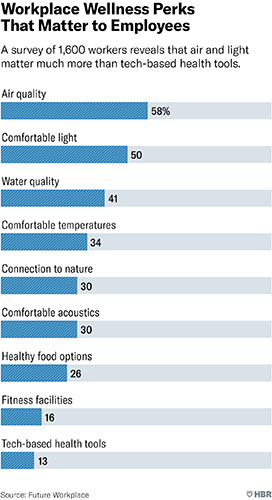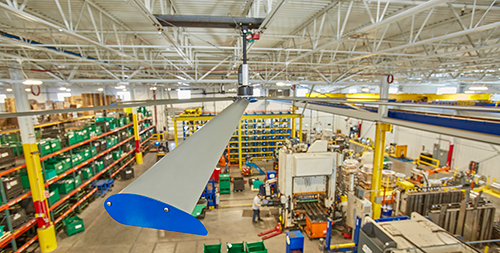Leverage Employee Comfort and Make it a Critical Part of Your Hiring Strategy

“How do I attract and retain employees for my distribution centers?” That’s a great question because the warehousing and storage market segment is growing exponentially. From 2010 through projections for 2022, CAGR for the Warehouse segment have come back at nearly 25% (Dodge Data & Analytics) with a growth projection of 17% year over year. Propelled by online retail, its growth curve has exceeded expectations and the industry not only needs to add several hundred thousand new employees, but it must also deal with backdoor losses. With turnover in warehousing currently greater than 33%, warehousing executives continue to look for ways to fill vacancies.
It turns out Harvard Business Review and the HVAC industry might have the answer—or a big part of it anyway.
According to a recent survey published in Harvard Business Review (Figure 1), air quality and comfortable temperatures ranked in the top five wellness perks employees want. Not health foods. Not fitness facilities. Employees want indoor air quality (IAQ), and they want to be comfortable doing their jobs.
 |
| Figure 1 |
Address IAQ
IAQ affects employee health and safety in all work settings, especially in warehouses and distribution centers. Pollutants such as exhaust fumes, volatile organic compounds (VOC), and mold exist in many warehouses. Poorly maintained HVAC systems also play a role in poor IAQ within a warehouse.
These pollutants create breathing problems, colds, allergies, a foggy mental state, and disease spread. Sick days, accidents, and employee turnover often result. Proper ventilation from a total ventilation solution not only improves IAQ; it reduces the likelihood of these unwanted employee actions from occurring.
Good air quality requires a constant changing of the air inside the warehouse. The HVAC industry calls these air changes per hour or ACH. It’s the process of removing the stale and polluted air and exchanging it with fresh outdoor air. Although this concept is simple in theory, geography and seasonal weather patterns play an important role in selecting the right ventilation solution for a warehouse or distribution center.
Consider a warehouse in a northern climate such as one in Duluth, Minnesota. A warehouse in this region typically has two different and important HVAC systems as part of its design. One system is a summer ventilation system. This system has some form of intake (typically louvers) and exhaust (generally an axial fan). These systems would provide better IAQ for the facility in the summer but would not work well bringing in cold outdoor air in the winter. The other HVAC system is a space heating system that heats the outdoor air and pushes that heated air into the warehouse. The result is cleaner and heated outdoor air for the employees.
Pay Attention to Thermal Comfort
The study also emphasizes the importance of thermal comfort. Employees are most productive when they feel comfortable. Complaints about being too hot, too cold, or too sticky (humid) are not good for employee morale.
Direct gas-fired units help keep employees comfortable in northern locations or when cooler temperatures arrive in other parts of the country. The outside air provided by these units helps pressurize the building. The pressurization reduces cold drafts near the dock doors, creating a more comfortable environment for the occupant.
Overhead high volume low speed (HVLS) fans are also helpful in cooler climates. The concept behind an HVLS fan is that it operates at very low speeds but moves large volumes of air, generating nothing more than a very gentle breeze. When the heat rises in a warehouse during the winter months, the HVLS fan forces warmer air downward. This process, destratification, creates a uniform, more comfortable temperature throughout the warehouse.
High humidity is another aspect of thermal comfort affecting employees. Many parts of the United States and other geographic locations deal with high humidity. Some regions have seasonal high humidity levels, while high humidity is a constant problem all year in other parts of the country.
The effects of humidity are more than excessive sweating and feeling hot. Fatigue, fainting, headaches, and confusion are some more serious effects. All reduce worker productivity and increase the potential for accidents.
A well-designed ventilation system can reduce humidity and maintain thermal comfort. Moving air through the facility provides a cooling effect on employees. The HVLS fan (Figure 2), helpful in winter, also offers verifiable relief for workers in summer. Airflow from HVLS fans has a cooling effect on workers when it gently blows across their skin.
 |
| Figure 2 |
Other circulating fans offer spot cooling when combined with the HVLS and other ventilation equipment. These fans maintain thermal comfort for workers in warehouses regardless of season or geography.
Protect Against Disease
Protection again disease infection in your warehouse is not as cut and dry as upgrading your HVAC system. Stagnant air in poorly ventilated warehouses carries an assortment of pollutants, viruses, and mold spores that contributes to illnesses. Increasing the number of air changes decreases the likelihood of airborne pathogens spreading and employees getting sick.
UV-C technology offers another level of protection. UV-C lessens the potential of infection by inactivating airborne pathogens, including the COVID virus. While UV-C technology in ventilation applications takes many forms, one effective use places UV-C lights on overhead HVLS fans, pointing the UV radiation upward. This approach takes contaminated air from the lower portion of the room and circulates it to the ceiling, where it is exposed to powerful UV-C light as it moves across the fan blades. The airborne pathogens become inactive while protecting occupants from excessive exposure to UV radiation.
Reduce Accidents
The National Safety Council lists warehouses among the most dangerous workplaces. Slips and falls are common, and the cost averages $22,000 to $47,000 per worker in compensation claims. A well‐designed HVAC system minimizes slipping and falls related to moisture on surfaces. Good quality air also helps employees stay alert, minimizing accidents.
Research from Harvard Business Review points to IAQ and thermal comfort as major selling points in attracting employees. Therefore, companies that need employees in their warehouses should use employee comfort as a winning strategy to attract and retain employees. An important aspect of the employee comfort strategy should include a total ventilation solution to address employee comfort, health, and safety. A well-designed ventilation system can make the difference in hiring the best employees. Learn more about the ventilation products for warehouses and distribution centers that improve employee comfort.


from